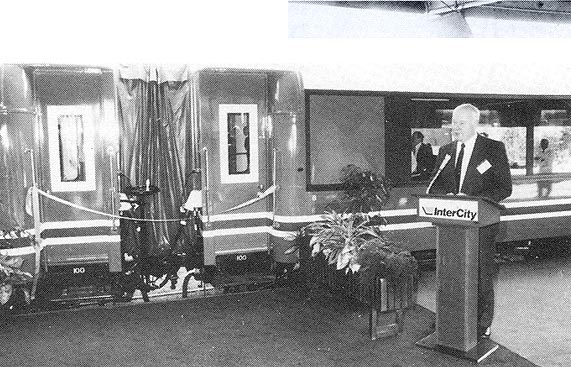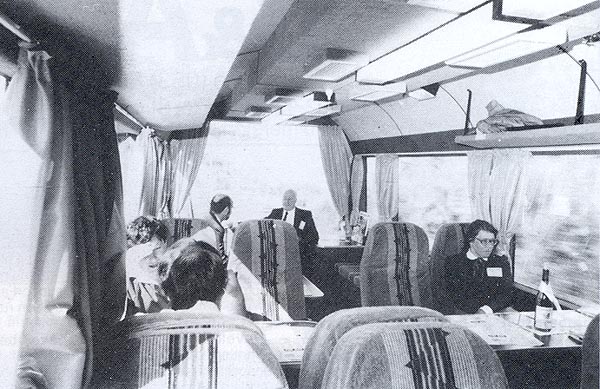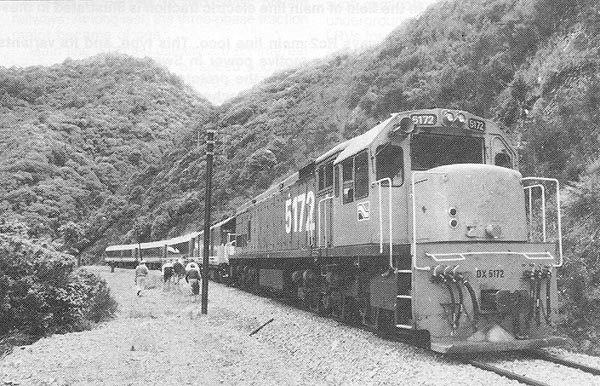Ormondville Rail Preservation Group Inc.
![]()
Bay Express proves popular
Source: 'Rails' magazine, March 1990, pp. 166-7
![]()
The Hawke's Bay line's new Bay Express, which entered service on 11 December (1989) is rapidly increasing its patronage, with well over 100 passengers making the run on many occasions over the summer holiday period. This new Wellington-Napier daily return service features the same 'panorama' window carriages which have proved popular on the Picton and Midland lines in the South Island, with the added attraction of a buffet-observation car with a large end window.
InterCity's Manager Mr John Bennett said patronage was "basically very good" as people found the new train was a better way of travelling to and from Hawke's Bay.
Work was now under way on developing and marketing a range of excursions linked to the train. These would cater for people making a day excursion to Hawke's Bay, giving them an hour or two visiting attractions in the Napier-Hastings area and others would be designed for Hawke's Bay people visiting the Wellington area for a weekend. Westland excursions and tours sold in conjunction with the Tranz-Alpine had proved very popular and had helped boost the use of that train, he said.
The normal consist for the Bay Express is three cars, an FM class guard's van and a DX class diesel-electric locomotive. Two of the cars each seat 51 passengers at tables, and are almost identical to cars used on the South Island trains, while the third car is an observation/buffet car, the first of its kind to be put into service by InterCity.
The three carriages were converted at the Addington Workshops in Christchurch for use on the new service.
The interiors (seats and carpets) of the carriages were stripped out and the exterior sheathing panels also removed. The framework around the windows was cut out and a new large window frame consisting of an RHS (rolled hollow section) 'ladder' was bolted into place.
The new windows (1 m high x 2m long) were bonded to the window frame using a urethane adhesive. These windows are double glazed. The outer panel in blue-green 'Eclipse' anti-sun glass, 6mm thick while the inner is clear 4mm glass. The two panes are bonded together using an adhesive to achieve an airtight seal. The result is reduced noise, prevention of condensation, and better thermal insulation, when compared with single glazing.
The existing seats on the carriages were removed and slightly modified to allow them to be mounted on rails fitted to the car floor. This allows seating to be adjusted or removed for repair. The seats are bent to give a slightly more upright position and the headrest is scooped out to compensate. When replaced, the seats have been arranged in pairs facing across tables. These tables were constructed especially for the conversion and are also mounted on rails.
The carpet on the carriages has also been replaced and walls covered with 'Frontrunner' material. The original 'net' type luggage racks have been removed and replaced with smaller sheet metal racks again covered in 'Frontrunner'.
The observation car has a kitchen and servery area built at one end. This area has been designed on an open plan basis and is not closed off from the passengers to encourage more use. Apart from minor detail differences, the servery on this car is identical to those fitted to the four servery cars currently in South Island service.
The major feature of this car is the observation end. This is in the area previously occupied by a toilet and the vestibule (lobby). The entire end of the car was demolished and a new steel floor structure wielded to the underframe. A new end structure was constructed from steel and this was heavily braced to the underframe using steel plate gussets.
It was also built into the existing side structure and new window frames. The rear window is not double glazed but is laminated from two sheets of safety glass to give protection against flying rocks, etc. All other glass in the cars has been toughened to prevent injury to passengers in the event of a breakage. A lounge area has also been provided at the observation end of this car. This provides casual seating and table. This area plus the servery reduces booked seating capacity in this car to 24. The seats are covered with Holdsworth (UK) woollen cloth. The seats in the other carriages are covered with wool woven into the synthetic back.
As a 'first' for big-window cars, the Bay Express consist is fitted with a pressure ventilation system. This uses a large fan to draw outside air in through filters and then below it into the saloon through roof ducts. Waste air finds its way through grilles in the car vestibules. The system is sized to change car air contents up to once per minute.
Heating systems are unchanged. These are 'Webasto' kerosine burning hot air heaters which distribute heated air through the floor ducts.
The catering service offers a range of light refreshments such as sandwiches, pies and cakes, plus more substantial food such as lamburgers, cold roast chicken and salad. Beer, wines, spirits, soft drinks, tea and coffee are available, and morning and afternoon teas are sold. A public address system is fitted for making operational announcements and for giving an onboard commentary to passengers. Power for the various services is generated from a small set carried in the guard's van. The normal crew comprises a steward or stewardess and a train manager.
The train leaves Wellington daily at 8am, and arrives at Napier at 1:30 pm. Departure from Napier is at 2:30pm with arrival back at Wellington at 8pm. To ensure that the observation car remains at the end of the train, the consist is turned on a triangle at Napier formed by the junction of the Gisborne and Napier Port lines, while in Wellington the train is remarshalled overnight and the observation car turned on the turntable.
Some of the photos from this article
Cover Photo (which appears on the previous page linked at the bottom of this webpage): The Hawke's Bay line has not in the past been regarded as particularly scenic, but this should change as the new Bay Express attracts more people to this route. Many of the line's more spectacular features, such as the Ormondville Viaduct, seen here, are remote from the main highway which perhaps explains why they are not as well known as they could be. In this photograph the new Bay Express with its panoramic windows and rear-end observation-buffet car, is seen on its inaugural run on 10 December last. (i.e. 10 December 1989)

The start of a new era of train travel on the Hawke's Bay line - Railways Corporation Chairman Mr Murray Smith declares the new train well and truly launched at the start of a special run to invited guests from Wellington to Napier on 10 December (1989). The public service started the following day.

Inside the buffet-observation car looking towards the rear of the train. Note the large rear viewing window and the lounge area well beyond the seating in the foreground. The caption of another similar (omitted) photo reads: "The buffet end of the buffet-observation car. The trunking at the right is part of the pressure ventilation system."

The buffet-observation car, rather similar in appearance to the Railfreight Systems business car used on the Silver Fern service temporarily last year. The photo was taken at Ashhurst on the inaugural run where a special stop was made to allow passengers to see the NZR's preserved F 163 steam locomotive which was on an excursion run from Palmerston North. Another (omitted) photo of this Ashhurst scene showed the F-class loco in the foreground. Its caption reads: "A contrast in styles - F 163, 109 years old and still going strong, with the latest in NZR passenger travel in the background."

Another photograph taken on the inaugural run when a special photo stop was made in the Manawatu Gorge.
All photos: 'Rails' magazine.